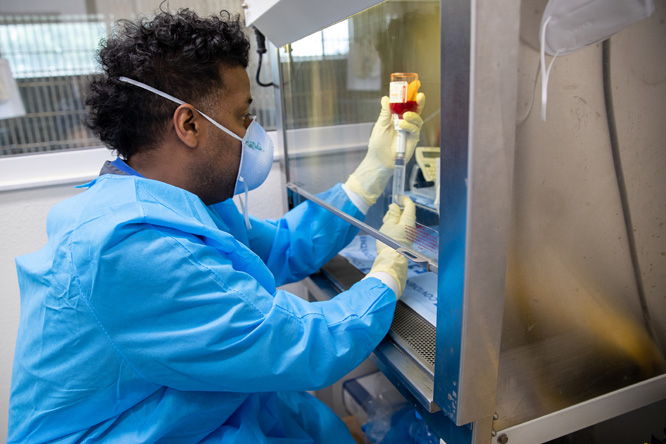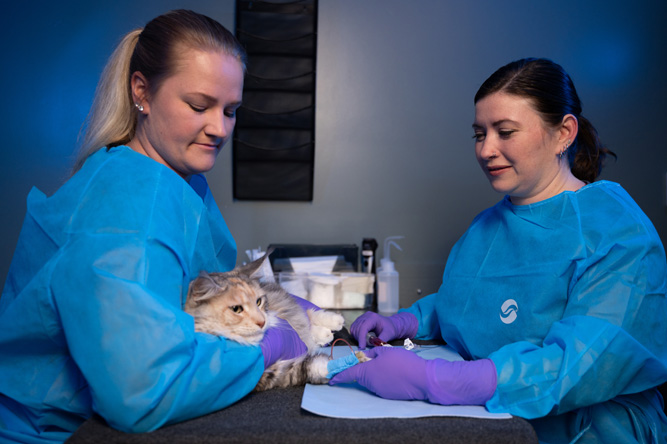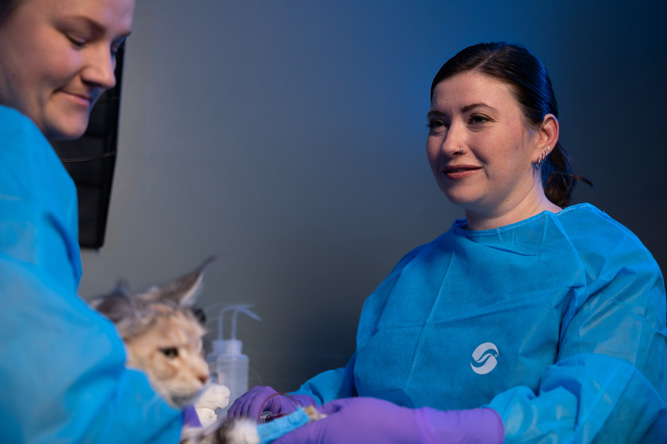Veterinary radiation oncology treatments for pets.
Receiving a diagnosis of cancer in your pet can be devastating. You are not alone – our team of compassionate professionals is here to walk you through the process from diagnosis to treatment to remission. Cancer treatments for pets have advanced over the years to meet human medicine standards, and our specialty pet hospital offers cutting-edge procedures like CyberKnife to treat cancer while giving your pet the highest quality of life possible.
Depending on your pet’s diagnosis, we offer a range of treatments to target their cancer. Some treatments are aggressive, while others may be more palliative and seek to control symptoms associated with a tumor and improve quality of life. The type of therapy prescribed for your pet will ultimately depend on tumor location and your goals for treatment.
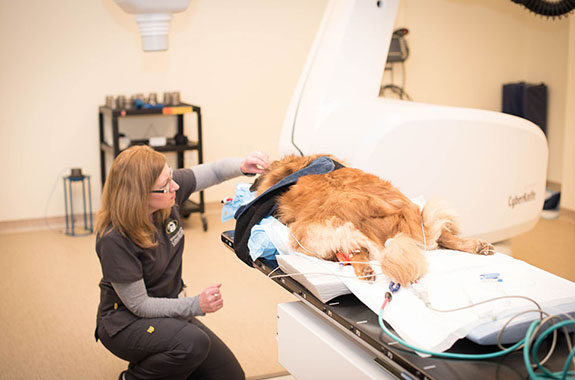
Conditions we treat.
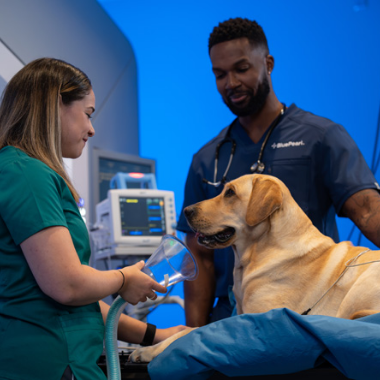
If your pet has cancer, you’ll have an entire oncology team helping to improve your pet’s quality of life so you can get back to what matters most – spending precious moments together.
- Bone cancer
- Liver and spleen cancer
- Lymphatic system cancer
- Mammary (breast) cancer
- Skin cancer
- Soft-tissue cancer
- Thyroid cancer
- Tumors
- Urinary system cancer
Services we offer.
Your pet will receive unparalleled medical care during their time at the hospital (and they’ll be spoiled with love and attention, too).
Conventional Radiation Therapy
One option your pet’s oncologist may recommend is radiation therapy. Radiation therapy, which uses high-energy beams of radiation directed at tumors, is used to treat solid cancers in the body. This may include tumors of the skin, nose, brain, mouth, bones and gastrointestinal system.
Our radiation oncology team uses imaging like CT and MRI as well as advanced technology like a linear accelerator, which produces and focuses a beam of radiation precisely where the tumor is located.
Intensity Modulated Radiation Therapy (IMRT)
IMRT is a new technology that delivers radiation more precisely to the tumor while relatively sparing the surrounding normal tissues, essentially “painting” doses of radiation to a tumor. IMRT has wide application in most aspects of radiation oncology for pets because of its ability to create multiple targets and avoid critical structures like healthy tissue.
By delivering radiation with greater precision, IMRT has been shown to minimize acute treatment-related side effects, making it possible to increase the therapeutic dose and ultimately improve local tumor control. IMRT has shown great promise in veterinary medicine, specifically for nasal and urogenital tumors.
Most IMRT protocols are fractionated, meaning that the total dose is broken up into multiple fractions, or treatments. In some cases, the number of treatments can vary from four to 20. These treatments may be administered daily or once weekly for up to four weeks.
Stereotactic Radiation Therapy (SRT)
SRT is a noninvasive way to deliver radiation to tumors with submillimeter accuracy. This allows us to treat cancer in pets with greater precision than traditional linear accelerators and IMRT machines. However, only certain cancer types are appropriate for treatment with the CyberKnife.
Our hospital uses a type of stereotactic radiation unit known as CyberKnife, which uses a robotic arm to deliver the entire therapeutic dose to a patient in one to three treatments, compared to conventional radiation therapy, which can employ up to 20 treatments. Surrounding normal healthy tissues receive little to no radiation, thus making radiation side effects minimal to absent.
CyberKnife treatment for pets is a noninvasive form of radiation therapy. The robotic arm allows movement around the patient to target a tumor and spare normal surrounding tissue. This allows the treatment to be delivered in a shorter time and decreases side effects to an almost unrecognizable level.
CyberKnife technology also allows us to treat tumors, such as lung or liver tumors, that haven’t historically been treated with radiation. The result is a more precise treatment, a significantly reduced number of anesthetic episodes, fewer hospital visits, and a better quality of life for your pet.
Our board certified specialists and oncology team.
Experience makes all the difference.
Our oncology team is made up of veterinarians, vet technicians and assistants, and support staff with rigorous training and experience in specialty medicine. The team works hand in hand to provide the comprehensive, compassionate care your pet needs and deserves. Because we’re a multidisciplinary hospital, the team can consult the expertise of other specialty departments, too.
Evan Ducker
DVM, DACVR-RODr. Evan Ducker is especially interested in innovative applications of palliative care.
- Diplomate, American College of Veterinary Radiology-Radiation Oncology
- Resident, Radiation Oncology, University of Georgia, Athens
- Internship, Small Animal Medicine & Surgery, BluePearl Specialty + Emergency Pet Hospital, Tampa, FL
- Doctor of Veterinary Medicine, University of Georgia, Athens
- Bachelor of Science, Agriculture – Biological Science, University of Georgia, Athens
Dr. Ducker is a huge soccer fan and enjoys spending time with his wife and two dogs, Nala and Isaac. He’s looking forward to trying new restaurants in the Philadelphia area.
Siobhan Haney
MS, VMD, DACVR-RO, MBADr. Siobhan Haney has lectured both nationally and internationally. In addition, she has authored and co-authored several studies on conventional and stereotactic radiation treatments in companion animals.
- Master of Business Administration, Penn State University, State College, PA
- Diplomate, American College of Veterinary Radiology-Radiation Oncology
- Residency, Radiation Oncology, Tufts University, Grafton, MA
- Internship, Small Animal Medicine & Surgery, Red Bank Veterinary Hospital, NJ
- Doctor of Veterinary Medicine, University of Pennsylvania, Philadelphia
- Master of Science, Biology, Rutgers University, Camden, NJ
- Bachelor of Science, Biology, George Washington University, Washington, D.C.
Outside of work, Dr. Haney enjoys organizing and decluttering, fine art, old homes, late night Netflix marathons, riding her Peloton and spending time with her two energetic children and her husband, who is also a veterinarian.
Frequently asked questions about radiation oncology for pets.
Below are some of the most common questions regarding radiation oncology treatments for pets. We’re here to help answer questions and address any concerns you may have about your pet’s well-being, so if your question isn’t answered here, please don’t hesitate to call us at 610.296.2099 (select option #6) or ask during your appointment.
What procedural and diagnostic steps will happen before my pet’s radiation treatment?
Most pets will require advanced imaging, such as computed tomography (CT) or magnetic resonance imaging (MRI), to allow radiation to be targeted specifically to the tumor while avoiding the healthy tissue around it.
Typically, our radiation oncologists will create a unique 3D plan using proprietary 3D treatment planning software and your pet’s CT or MRI images. Not all pets will require a 3D treatment plan – it largely depends on their specific tumor and anatomy. Our team will discuss if your pet needs a 3D treatment plan during your initial consultation.
Is there any pain associated with radiation treatments?
Conventional radiation and CyberKnife treatment provide a pain-free, non-surgical option for patients with inoperable or surgically complex tumors. The procedure is non-invasive, meaning no incision or cutting occurs and no recovery time is needed.
Often, our clients will report that their pets seem more comfortable after radiation treatments, which may result from reducing the tumor’s size, which decreases tumor-related side effects.
How long will my pet have to stay at the hospital?
Most radiation treatments are performed on an outpatient basis. Pets usually need to stay at the hospital for about two to three hours but may stay for up to eight hours for treatment. The length of stay depends on the type of radiation therapy administered to your pet.
What are the side effects associated with radiation treatment?
The side effects associated with any radiation treatment depend on the number of treatments and the location of the tumor. Typically, side effects consist of temporary inflammation of any tissue surrounding the tumor site, but inflammation usually resolves within two weeks of the completion of treatment.
Side effects with CyberKnife are typically very minimal to absent, which is one of the significant advantages of CyberKnife therapy over conventional radiation therapy. However, not every pet is a candidate for CyberKnife, nor is it the right treatment for every type of tumor.
Any side effects ultimately depend on the location of your pet’s tumor and will be discussed before treatment.
Why does CyberKnife radiotherapy require fewer treatments than conventional radiation therapy?
CyberKnife radiation therapy is so precise and accurate that we can deliver an entire dose of radiation in far fewer treatments. The surrounding healthy tissue receives minimal radiation, significantly shortening the time required for treatment.
It is important to note that cancer biology is complex and some tumors, such as pituitary and urogenital tumors, may respond better to more prolonged courses of radiation therapy than to CyberKnife. Your pet’s oncologist will review all treatment options with you to decide what course of action is best for your pet.
After radiation treatments, will my pet’s tumor shrink or disappear?
The effects of radiation treatment vary and may occur gradually and over time. Depending on your pet’s medical condition, the timeframe can range from days to months or years. Some tumors may decrease in size more slowly than others, while others may stop growing.
Four to six months after radiation treatment, patients may have a repeat CT scan to identify if the tumor treated was reduced in size.
Is my pet still a candidate for radiation treatments if they’ve previously had radiation therapy?
This will be determined based on the tumor’s location, the dose of radiation previously received and the length of time after initial treatment. It is important for our radiation oncologists to have access to your pet’s medical records and radiation treatment records so the appropriate radiation protocol can be prescribed.
What is the cost of radiation treatments? Are they covered by pet insurance?
The cost of radiation treatment varies based on the type and location of the tumor and the number of fractions needed. During your initial consultation with the oncologist, you’ll receive an estimate for treatment, including advanced imaging.
Most veterinary insurance companies cover a portion of radiation treatment, depending on your pet’s policy. Don’t hesitate to contact us at 844.738.2927 for more information about fees or using pet insurance.
What should I do if I don’t live close to BluePearl Veterinary CyberKnife Cancer Center?
We understand that transporting your pet to appointments can be difficult with work and family obligations. For our patients who travel to our hospital from another state, we work with a local hotel, the Sheraton Great Valley, which is less than two miles from our practice and is very pet-friendly. The hotel offers a shuttle service to BPVCCC and a discounted room rate for our clients.
Please contact our office for more information about transportation, boarding and hotel accommodation options.
Why does radiation therapy require anesthesia?
Unlike human radiation therapy, we cannot rely on our patients to stay perfectly still during treatment. Anesthesia is unequivocally the least stressful option to ensure there is no movement during radiation.
The length of anesthesia time will vary depending on the type of radiation treatment your pet is receiving, but it can range from just a few minutes to two hours. A veterinary nurse dedicated to overseeing your pet’s anesthesia continuously monitors your pet’s vital signs throughout treatment.
How can I find an oncologist for pets near me?
In most cases, your primary veterinarian will be able to refer you to a specialist. Our sister hospital, BluePearl Pet Hospital in Malvern, is a 24-hour specialty and emergency hospital located directly next door with a team of veterinary oncologists on staff.
You also have the option to research online. For your convenience, we’ve listed two websites below:
- ACVR – American College of Veterinary Radiology
- ACVIM – American College of Veterinary Internal Medicine
We recommend the Animal Cancer Foundation’s resources for learning more about nutrition tips, clinical trials, and other resources for pets with cancer.
You are always welcome to call BluePearl Malvern at 610.296.2099 for assistance in finding the best pet oncologist in the Chester County area.
